|
April is National Minority Health Month
|
||||||||||||||||||
|
Although cigarette smoking has declined significantly since 1964, very large disparities in tobacco use remain across groups defined by race, ethnicity, education level, socioeconomic status and across regions of the country. There is a wealth of information available about this topic. Here are a few resources: Best Practices User Guide:Health Equity in Tobacco Prevention and Control from the Centers for Disease Control and Prevention (CDC); A Practitioner’s Guide for Advancing Health Equity: Community Strategies for Preventing Chronic Disease – Section 2: Maximizing Tobacco Free Living; and CDC’s video, Unequal Opportunity Killer.
 The CDC’s Office on Smoking and Health and the Division of Cancer Control and Prevention fund national networks to address tobacco-related and cancer health disparities in their respective populations – these Networks have information and resources specific to tobacco in their communities.
Asian Pacific Partners for Empowerment, Advocacy, and Leadership: RAISE (Reaching Asian Americans Pacific Islanders Through Innovative Strategies to Achieve Equity in Tobacco Control and Cancer Prevention.)
Keep It Sacred National Native Network:KeepItSacred.itcmi.org
National Alliance for Hispanic Health: Nuestras Voces
National African American Tobacco Prevention Network:naatpn.org
Network for LGBT Health Equity at Centerlink:LGBTHealthlink.org
Additional networks that address special populations and tobacco use are:
Geographic Health Equity Alliance addresses geographic health disparities.
National Behavioral Health Network for Tobacco and Cancer Control addresses health disparities among behavioral health consumers.
SelfMade Health Network fosters prevention among vulnerable populations.
|

Comments